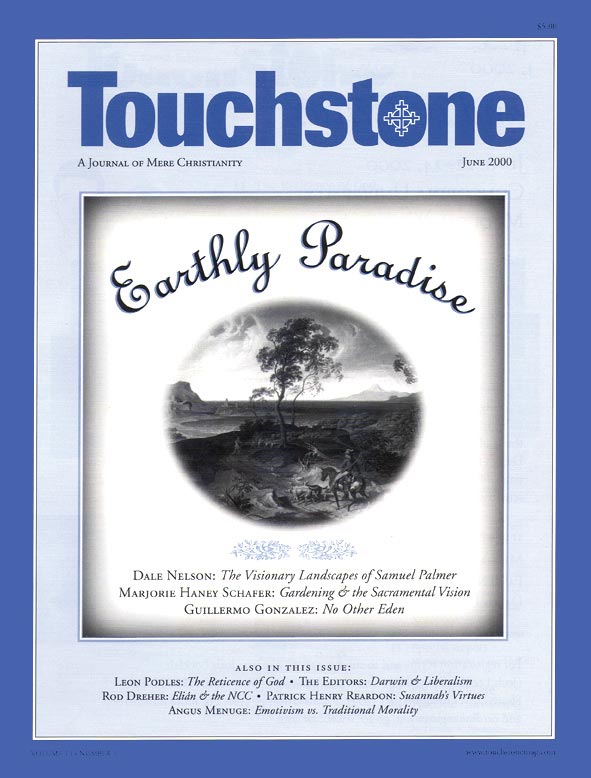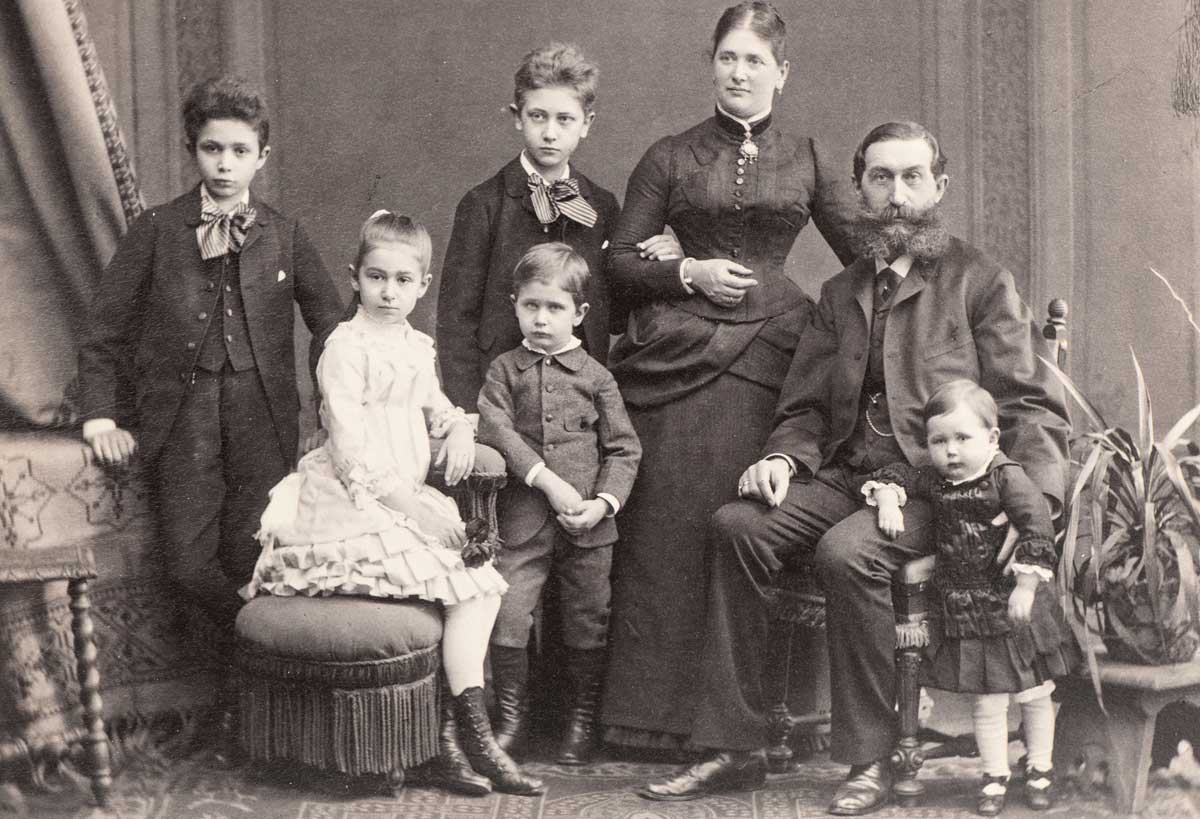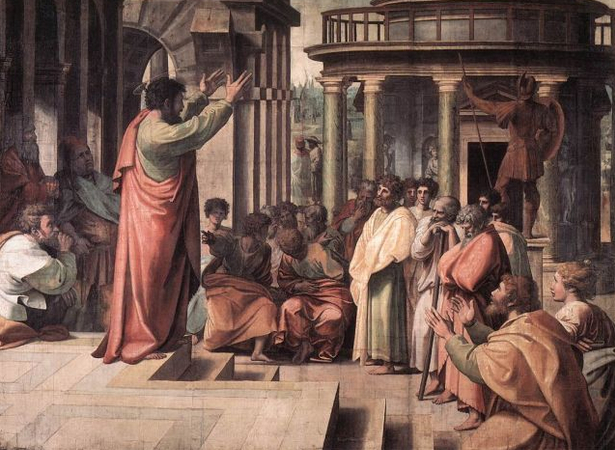The Corners of Paradise
Underriver: Samuel Palmer’s Golden Valley
by Griselda Barton and Michael Tong
Brasted Chart, Westerham, Kent: Froglets, 1995
(32 pages; £12.95, paper)
Samuel Palmer
(Ashmolean Handbooks series)
by Colin Harrison
Oxford: Ashmolean Museum, 1997
(80 pages; £10.95, cloth)
by Dale Nelson
“The days will come, in which vines shall grow, each having ten thousand twigs, and in each twig ten thousand shoots, and in each one of the shoots ten thousand clusters, and on every one of the clusters ten thousand grapes. . . . And when any one of the saints shall lay hold of a cluster, another shall cry out, ‘I am a better cluster, take me; bless the Lord through me.’ In like manner, the Lord declared that a grain of wheat would produce ten thousand ears, and that every ear should have ten thousand grains, and every grain would yield ten pounds of clear, pure, fine flour; and that all other fruit-bearing trees, and seeds and grass, would produce in similar proportions; and that all animals feeding only on the productions of the earth, should in those days become peaceful and harmonious among each other, and be in perfect subjection to man.”
If Samuel Palmer (1805–1881) had read these words during his youthful visionary years, he surely would have approved of them not as a millenarian prophecy (reported by St. Irenaeus), but as a torrent of words partaking of the “excess” he sought for his paintings and drawings. Those works specify no time, but do specify a place, Kent in southern England.
“The Magic Apple Tree,” an 1830 watercolor, presents a tidal wave of ripe golden wheat rushing towards a church steeple, in front of which is “an apple tree loaded to the extremity of every twig with bright crimson apples so numerous and enormous as far to surpass the utmost stretch of possibility.” Thus the “excess” appeared to Palmer’s son and biographer, who was also the eventual destroyer of an immense quantity of his father’s notes and sketches. A. H. Palmer wrote for audiences more accustomed, in their religious art, to conventionalized biblical scenes with well-scrubbed Galilean peasants than to such works of an “ill-controlled and powerful imagination.” The biographer was, likewise, uneasy about the sanity of William Blake, whose disciple Samuel Palmer was during the last three years of Blake’s life (1824–1827). Those years were the beginning of Palmer’s period of greatest achievement, when he was still a very young man.
Like Blake’s, Samuel Palmer’s achievement has been a “discovery” of our own century. Two recent books and two fine reproductions present some of Palmer’s most characteristic masterpieces. Some of these works by the young Palmer recall Brueghel or Blake, or even icons, and some of them are passionate and intense; others provide for us serene, assured visual analogues of J. R. R. Tolkien’s Shire.
Palmer, the son of an unambitious London bookseller, created fascinating designs even before he met Blake at the age of 19. Palmer’s 1824 sketchbook has been reproduced in facsimile by the William Blake Trust (1962). Recurrent images, even so early, are huge harvest moons or crescent moons, churches, trees, shepherds, tilled fields, studies of leaves, sheep, and oxen; in the midst of these drawings, a monk; a design of the creation of the heavenly lights; and a ghastly image: as a vast ichthymorphic hellmouth yawns to receive him and Satan falls from heaven, the unrepentant thief shrieks and wrenches his right hand free, the spike tumbling.
That is the only hellish image that Palmer ever made, that survives, anyway. For he launched upon the making of the most convincing series of paradisal images in English art. They are “paradisal,” not strictly pictures of Paradise, because the small human figures in them work, tending sheep, planting, harvesting. Sawn wood bespeaks hard exertion. Still, the atmosphere is that of Psalm 65:9–13: “Thou visitest the earth. . . . Thou crownest the year with thy goodness. . . . The little hills rejoice on every side. The pastures are clothed with flocks; the valleys also are covered with corn; they shout for joy, they also sing.”
As Raymond Lister says in his introduction to the Underriver booklet, in the paintings and drawings Palmer produced during his approximately seven years in Kent (1826–1834, especially the first four years or so), “A little cornfield in an English valley could be transformed into a vision of divine munificence, or paradisal illumination.” Palmer’s words about a series of small engravings by Blake apply better to these works of his own: “They are visions of little dells, and nooks, and corners of Paradise; models of the exquisitest pitch of intense poetry. . . . Intense depth, solemnity, and vivid brilliancy only coldly and partially describe them. There is in all such a mystic glimmer as penetrates and kindles the inmost soul, and gives complete and unreserved delight. . . . The drawing aside of the fleshly curtain, and the glimpse which all the most holy, studious saints and sages have enjoyed, of that rest that remaineth to the people of God.”
Self-devoted to this artistic enterprise, Palmer had the example of Blake, a man he revered in memory, many years later, as one whose aim was single, whose path was straightforward, whose wants were few—“so he was free, noble, and happy.” Like Blake seeing a multitude of angels praising God, when his corporeal eye beheld the sun, Palmer could see branches form a Gothic church window—“but sometimes trees are seen as men. I saw one, a princess walking stately and with a majestic train.” Palmer caught the revelatory moments: “Sometimes the rising moon seems to stand tiptoe on a green hill top to see if the day be going and if the time of her regency be come.”
bulk subscriptions
Order Touchstone subscriptions in bulk and save $10 per sub! Each subscription includes 6 issues of Touchstone plus full online access to touchstonemag.com—including archives, videos, and pdf downloads of recent issues for only $29.95 each! Great for churches or study groups.
Transactions will be processed on a secure server.
more from the online archives
calling all readers
Please Donate
"There are magazines worth reading but few worth saving . . . Touchstone is just such a magazine."
—Alice von Hildebrand
"Here we do not concede one square millimeter of territory to falsehood, folly, contemporary sentimentality, or fashion. We speak the truth, and let God be our judge. . . . Touchstone is the one committedly Christian conservative journal."
—Anthony Esolen, Touchstone senior editor











